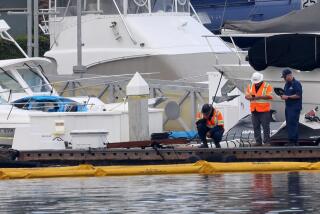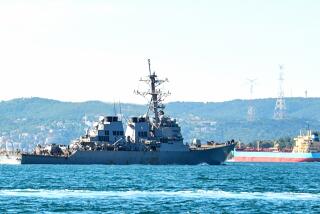Real Ships in Fake Combat : Military: The Princeton and four other vessels show off their firepower during war games staged about 100 miles off Ventura County’s coast.
From a side deck of the cruiser Princeton, Capt. J. Cutler Dawson stared intently through a pair of binoculars on Thursday at the remains of a 25-foot Styrofoam patrol boat his crew had just blasted out of the water about 100 miles off the Ventura County coastline.
As officers, crew members and reporters removed the earplugs that protected them from the deafening sounds of the ship’s five-inch guns, Dawson declared the simulated battle an overwhelming success.
“It looked real good to me,” Dawson said, scanning the horizon through a heavy wall of smoke still being emitted by the now-silent guns.
“We have the ability to tape it and study the operation later,” Dawson said. “But the best way to get an instant feel for it is to look at it through your own eyeballs.”
The display of U.S. Navy firepower was not for the captain’s eyes only. It was also a rare opportunity for area news reporters and photographers to observe firsthand the live-fire exercises carried out routinely in the 35,000-square-mile ocean test range controlled by the Naval Air Warfare Center Weapons Division.
The day’s events included the firing of several SM-2 missiles and a sweeping tour of the $1.2-billion Princeton--the Navy’s newest and deadliest Aegis class cruiser. It also featured an informal lunch served by seamen wearing bright, floral print shirts in the officers wardroom--all part of the Navy’s efforts to woo the public in times of tight federal budgets.
Dawson and his officers said the Navy should be more open to public scrutiny in the post-Cold War era because there is no longer a threat of Soviet vessels on the high seas.
“This ship is a big investment for the American public,” Dawson said, seated in the captain’s chair on the bridge and watching the convoy of four other escort vessels. “They ought to be able to see what they’re getting.”
The media tour showed off the Navy’s newest and most advanced combat ship in the fleet, said Lt. Daryl Woodworth, the Combat Information Center’s officer who guided a group of journalists through the vessel.
The Combat Information Center is the central brain of the high-tech warship, with computers and miles of wiring connecting it to the ship’s sonar and radar sensors and silos packed with Tomahawk and SM-2 missiles stored forward and aft.
“If you are a Tom Clancy fan, this is the place it all happens,” Woodworth said as he entered the dark, air-conditioned combat center vividly described in one of the author’s novels.
“This screen here tells you who is friendly and who isn’t,” Woodworth said as he pointed to one part of the ship’s intricate radar system. A clutch of enlisted sailors dressed in trademark Navy blue uniforms hovered around each glowing screen.
Most of the officers and enlisted men down cup after cup of coffee to stay awake during their marathon shifts, yet another Navy tradition portrayed in Clancy’s novels.
“I’m trying to stay off the stuff myself,” Woodworth said, explaining that most of the 390 sailors and 30 officers who make up the Princeton’s all-male crew use the coffee to keep them alert during their 12-hour shifts.
Although the U.S. Navy is no longer challenged by Soviet ships, Lt. Steve Anderjack is one of those who believe in a continuing need for all this high-tech warfare and spit-and-polish military discipline.
Anderjack was on the bridge during the Gulf War when the Princeton struck a mine set afloat by Iraqi troops.
The blast ripped through the ship like an earthquake on the sea, crew members said, tearing a gaping hole in the ship’s front section and forcing it to a port in Dubai, United Arab Emirates, for a long period of repairs.
The Gulf War is reason enough for the United States to continue honing this sort of sophisticated weaponry, Anderjack said.
Navy officers also point out other reasons to continue the drills for new challenges on the seas, including the cruiser’s role in drug interdiction and keeping watch on a new breed of diesel-powered submarines that may be put into action by some Third World nations.
The Princeton was built to protect aircraft carriers from an air assault. Its prowess at sea was the focus of the day’s ultimate exercise: a chance to fire its missiles at several flying drones launched from another aircraft several hundred miles away.
Pitting an unmanned drone against the newest class of warship may not seem fair, but practice is practice, officers said.
The Princeton spent much of the afternoon maneuvering into a safe firing zone. But it never got a chance to fire a missile.
But all four of its companion ships fired missiles at two drones approaching the convoy. “We spend a lot of time running all around the ocean looking for a patch where it’s safe to shoot,” said Cmdr. James (Red) Smith, the ship’s executive officer.
“It’s frustrating, really, and a bit boring, to spend all these hours, and sometimes days, moving all over the place for literally a few moments of excitement,” he said.
Moments later, another crew member shouted “Birds away!” and a plume of fire and smoke accompanied the launching of thousands of dollars of missile technology.
“Damn, how much do you think that costs?” a crewman said under his breath as the missile chased its elusive target into the clouds.
More to Read
Sign up for Essential California
The most important California stories and recommendations in your inbox every morning.
You may occasionally receive promotional content from the Los Angeles Times.










